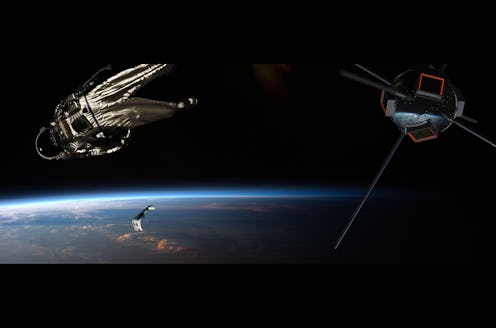Life
Adopt A Piece Of Space Junk With This Art Project

In the decades since the first satellite entered the Earth’s orbit, humans have created hundreds of millions of pieces of space debris. As the skies become ever more crowded with rocket parts, nose cones, and fuel tanks, a new project is allowing people to “adopt” space junk and communicate with these now defunct instruments... over social media. Through the interactive art project Adrift, audiences are able to connect "personally, audibly, and visibly" with this orbital junk, receiving messages via Twitter from one of three large pieces of debris as they pass overhead at thousands of miles per hour.
Created by filmmaker Cath Le Couteur and sound artist Nick Ryan in conjunction with Creative Technologist Dr. Daniel Jones, Adrift has been two years in the making. “I was researching another feature film project and I came across the story of an astronaut who dropped his spatula in space in 2006, which went on to become a piece of space junk," Le Couteur tells Bustle. "I found this very provocative. Here was this mundane, human instrument, orbiting earth as a piece of junk at a dangerous 17,000 miles per hour! Arguably the most deadly kitchen instrument ever." The lonely, beautiful image stuck with Le Couteur, and she dug deeper into the phenomenon. "As I read up more I discovered that the huge quantities of space junk is now a very real, contemporary crisis."
Three pieces up for adoption include Vanguard, the first solar powered satellite launched into space in 1958 (and currently the oldest piece of space junk in orbit); Suitsat, a Russian spacesuit filled with trash that was pushed out of the International Space Station in 2006; and Fengyun, a Chinese weather satellite that was intentionally destroyed by an anti-satellite missile in 2007. The notorious blast is considered the worst space debris event of all time, nearly doubling the amount of human-made waste in space.
With Adrift, you can now follow these pieces of space junk on Twitter and receive status updates. "When audiences tweet the space junk, each piece of junk returns a combination of narrative stories about its history and feelings as well as live data," Le Couteur says.
In addition to the interactive aspect of the project, Le Couteur has directed and produced a short documentary raising awareness about the issues of space junk, while Ryan has created a way to listen to the debris. An electromechanical instrument that tracks 27,000 pieces of space junk in real-time and transforms the silent trash into sound as it passes quickly overhead. The eerie noises emitted from the elegant machine resemble the score to a horror or sci-fi film — an apt metaphor, as the specks of trash could eventually turn into a menacing problem.
The amount of trash whirling through space is astounding. There are currently 16,300 pieces of space trash larger than 10 centimeters, 670,000 pieces between one and 10 centimeters, and 200 million human-made objects larger that one millimeter encircling the Earth. While most of the junk is not very large, the speeds at which the trash travels make it dangerous.
Spinning through space at thousands of miles an hour, even something as small as few thousandths of a millimeter can cause damage to a space station or satellite. This has already been observed in the International Space Station Cupola, when a speck of paint or metal gouged a 7 mm-diameter circular chip in one of the space station's windows. A branch of NASA tracks the orbital debris crisis and keeps tabs on some of the larger pieces that could cause serious harm, but cleaning up the trash is problematic.
"Along the way, Nick and I have met so many brilliant scientists and innovators who want to try and solve this problem and yet are deeply frustrated. There is no money to be made in cleaning up space junk. So they don’t have funding to come up with workable solutions," Le Couteur tells Bustle. "You aren’t currently allowed to ‘touch’ someone else’s piece of space junk, even if you wanted to clean it up. You can’t push someone else’s junk down into the atmosphere to burn it up, or push it up into a graveyard orbit (so it won’t threaten our working satellites). None of this is currently possible because countries don’t want anybody else getting close to their objects in space." While the creators didn't set out with the goal to change policy, there project could have some real positive impact."If our project can create an impact and help raises awareness," she says, "our hope is that this might then open a window of opportunity for the innovators who are trying to solve it."
To learn more, check out Project Adrift here, or at their week-long show at Hackney House in London coming up in early 2017.
Images: Courtesy of Adrift